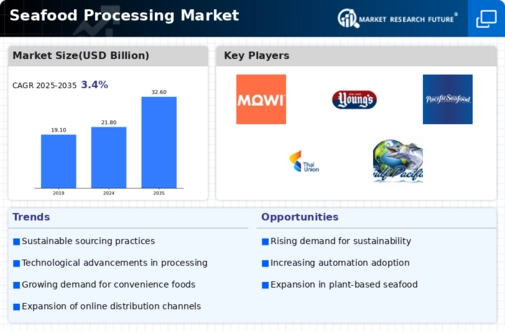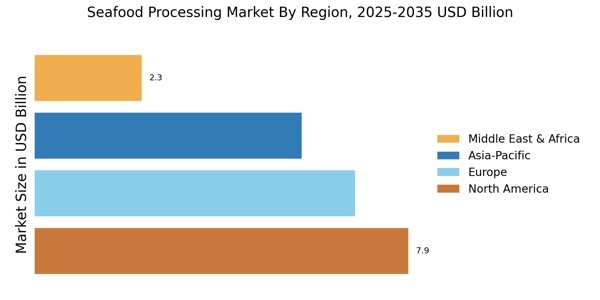Rising Demand for Seafood Products
The Seafood Processing Market experiences a notable increase in demand for seafood products, driven by changing consumer preferences towards healthier diets. As consumers become more health-conscious, the consumption of seafood, which is rich in omega-3 fatty acids and other essential nutrients, is on the rise. Reports indicate that seafood consumption has grown by approximately 3.5% annually, reflecting a shift in dietary habits. This trend is further supported by the increasing awareness of the health benefits associated with seafood, leading to a surge in processed seafood products. The Seafood Processing Market is thus positioned to capitalize on this growing demand, as manufacturers innovate to provide a variety of seafood options that cater to health-oriented consumers.
Sustainability and Environmental Regulations
Sustainability initiatives and environmental regulations are increasingly influencing the Seafood Processing Market. As concerns regarding overfishing and environmental degradation grow, regulatory bodies are implementing stricter guidelines to promote sustainable fishing practices. This shift compels seafood processors to adopt eco-friendly practices, such as sourcing from certified sustainable fisheries and reducing waste during processing. The Seafood Processing Market is thus adapting to these regulations, which not only help in preserving marine ecosystems but also appeal to environmentally conscious consumers. Companies that prioritize sustainability may gain a competitive edge, as consumers are more likely to support brands that align with their values.
Growing Interest in Value-Added Seafood Products
The Seafood Processing Market is experiencing a growing interest in value-added seafood products, which offer convenience and enhanced flavors. Consumers are increasingly seeking ready-to-eat or easy-to-prepare seafood options, such as marinated fillets, seafood snacks, and pre-cooked meals. This trend is driven by busy lifestyles and the desire for quick meal solutions without compromising on quality. The market for value-added seafood is projected to grow significantly, with estimates indicating a compound annual growth rate of around 5%. As a result, the Seafood Processing Market is likely to focus on developing innovative value-added products that cater to the evolving preferences of consumers.
Expansion of E-commerce and Online Sales Channels
The Seafood Processing Market is witnessing a significant transformation due to the expansion of e-commerce and online sales channels. With the increasing penetration of the internet and mobile devices, consumers are increasingly turning to online platforms for purchasing seafood products. This trend is particularly evident in the rise of direct-to-consumer models, where seafood processors can sell their products directly to consumers, bypassing traditional retail channels. Reports suggest that online seafood sales have surged, with a projected growth rate of over 20% in the coming years. This shift presents an opportunity for the Seafood Processing Market to reach a broader audience and enhance customer engagement through digital marketing strategies.
Technological Innovations in Processing Techniques
Technological advancements play a crucial role in enhancing the efficiency and quality of the Seafood Processing Market. Innovations such as automated processing lines, advanced freezing techniques, and improved packaging solutions are transforming traditional processing methods. These technologies not only increase production capacity but also ensure better preservation of seafood quality, thereby extending shelf life. For instance, the implementation of high-pressure processing (HPP) has gained traction, allowing for the reduction of pathogens while maintaining the nutritional value of seafood. As a result, the Seafood Processing Market is likely to witness a shift towards more sophisticated processing methods, which could lead to higher product quality and consumer satisfaction.


















Leave a Comment